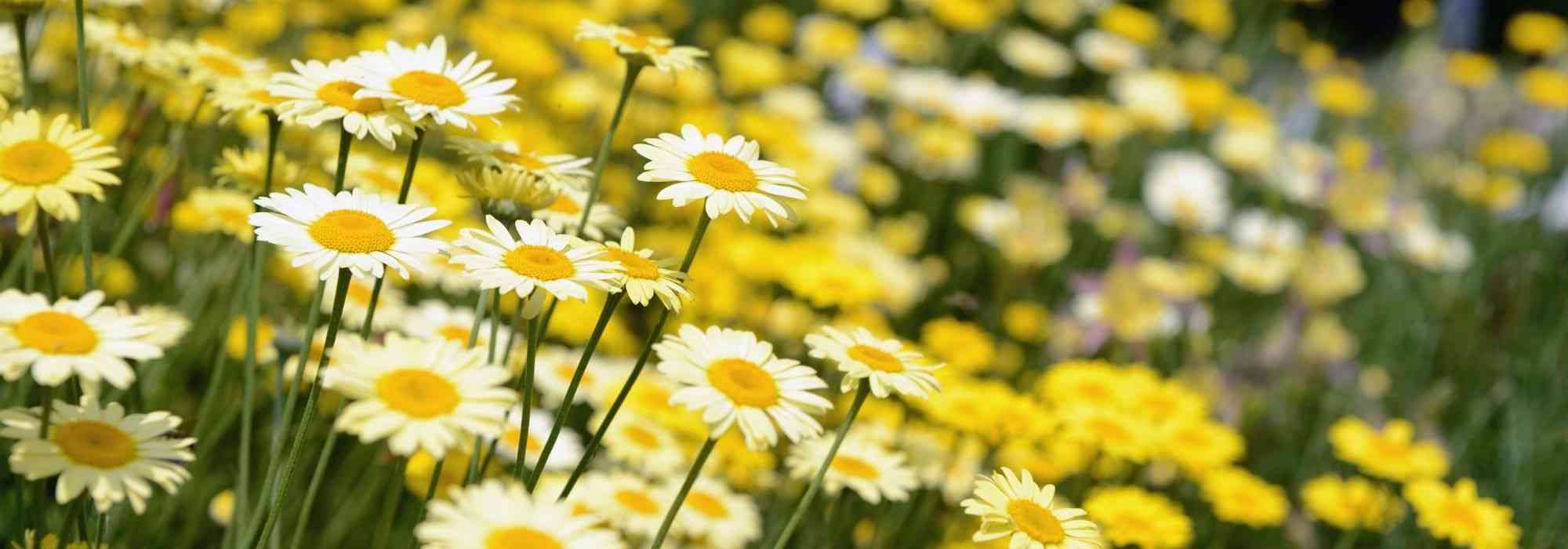
Associate the anthemis
Our ideas to enhance these wildflowers
Contents
It’s not always easy to navigate the world of anthemis, which is often confused with other plants like chamomile. Some explanations are in order.Among the “true anthemis”, we find notably: Anthemis carpatica or Carpathian chamomile, Anthemis sancti-johannis or St. John’s anthemis, and Anthemis tinctoria, more commonly known as “dyer’s chamomile” or “false chamomile.” Perennials, these have good hardiness and can be planted in open ground without issue.The Canarian or Madeiran anthemis are less hardy and considered annual plants. They are now referred to as Argyranthemum in Latin. In contrast, true chamomile or Roman chamomile is classified under the genus Chamaemelum.
Plants of sun and dry soil, anthemis bloom abundantly during summer. Their daisy-like flowers can be used in a variety of situations. White-flowered anthemis brighten up borders, rockeries, and romantic beds. Yellow varieties and species can add colour to a cottage garden or a wildflower garden. Anthemis works wonderfully in bouquet arrangements. You can therefore incorporate this charming perennial into a cut flower garden, allowing you to pick and create your own floral arrangements for the home. Discover our inspirations for pairing your white or yellow anthemis without delay!
⇒ Visit our page Anthemis: planting and care to learn all about this plant with star-shaped flowers.
In a cottage garden
Capable of forming spectacular rounded clumps in a short time, the anthemis is well-suited for planting in an English cottage garden. The large pale yellow flowers of Anthemis tinctoria ‘Wargrave Variety’ and Anthemis tinctoria ‘E.C. Buxton’ integrate beautifully into a vibrant scene composed of summer-flowering perennials. At the back of the border, install large plants: hollyhocks or lavatera. The mauve blue of Lavatera ‘Blue Bird’ is suitable and pairs easily with the yellow of the anthemis. In this flowering border with lush vegetation, many medium-sized plants in shades of yellow, blue, and mauve can find their place. Here is a selection of interesting varieties for dry soil: Aquillea ‘Moonshine’, Digitalis grandiflora, Salvia nemorosa ‘Serenade’, Verbascum phoeniceum ‘Violetta’. To avoid monotony, add a plant of a different hue, such as orange or purple. The Allium sphaerocephalon with its purplish-red umbels thrives in well-drained, dry soils. The Oenothera versicolor, on the other hand, produces an abundance of orange flowers. Finally, the lowest plants fill the empty spaces in the foreground: mauve pinks, Senecio polyodon, Potentilla megalantha, Veronica spicata ‘Nana Blue’ and Sedum takesimense ‘Atlantis’.
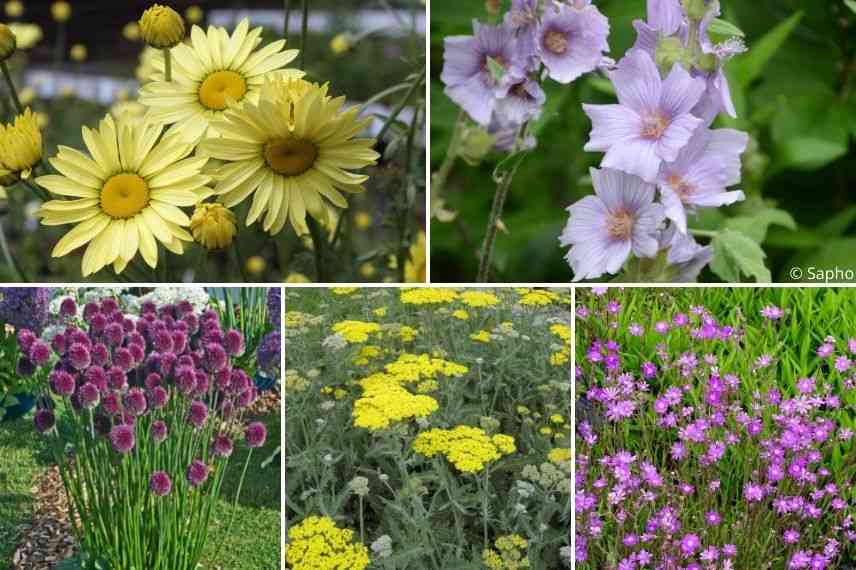
Anthemis tinctoria ‘Wargrave Variety’ (photo ben rushbrooke), Lavatera ‘Blue Bird’, Allium sphaerocephalon, Achillea ‘Moonshine’ and Senecio polyodon
Read also
Anthemis : planting and careIn a naturalistic border
Saint John’s Anthemis or Anthemis sancti-johannis, particularly hardy and with a natural appearance, fits well in country-style gardens. Its clump of grey-green foliage is topped with heads tinted in a bright orange-yellow. This flowering display, airy and light in its simplicity, can be enhanced alongside dry soil grasses, whether upright or trailing, of varying heights. They are essential in these natural areas. Tall varieties like the upright panic Panicum virgatum ‘Cloud Nine’ or Muhlenbergia rigens with arching foliage should be placed at the back. Lower down, the sheep fescue standing tall or the Sporobolus heterolepis with its fountain-like soft foliage should be planted at the front. To add colour to this rural scene, include plants that resemble wildflowers: the yellow Oriental cornflower, a red poppy (Papaver orientale ‘Allegro’ for example), the mauve fragrant scabious, and the annual California poppies (Eschscholzia californica) and love-in-a-mist.
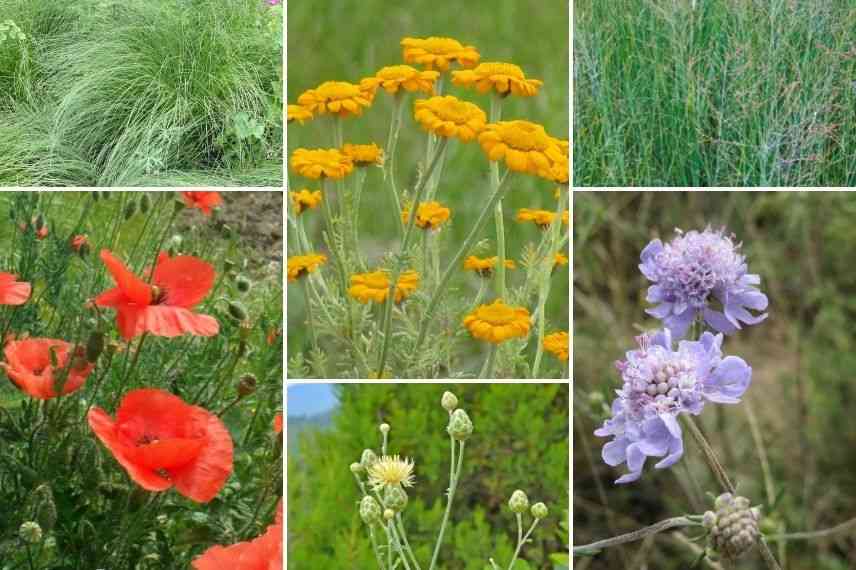
Sporobolus heterolepis, Anthemis sancti-johannis, Panicum virgatum ‘Cloud Nine’, Oriental poppy, Centaurea orientalis, and Scabiosa canescens
Discover other Anthemis
View all →Available in 2 sizes
Available in 2 sizes
Available in 2 sizes
Available in 1 sizes
Available in 1 sizes
Available in 1 sizes
Available in 1 sizes
Available in 1 sizes
In a romantic scene
In romantic gardens, light and soft shades are preferred. For this decor, white anthémis are therefore welcome (Anthemis tinctoria ‘Sauce Hollandaise’, Anthemis carpatica ‘Karpatenschnee’). You can plant your anthémis alongside the fragrant pink flowers of Dictamnus albus var. purpureus, a gaura, or a lavender. Very hardy and excellent in stony and dry soil, the stork’s bill (Erodium manescavii) can perfectly replace the classic hardy geranium often seen in this type of garden. Lighten the scene with the airy inflorescences of gypsophila and vervain ‘Bampton’. Use plants with decorative foliage. Grey leaves add softness and easily blend with pastel colours: Dorycnium hirsutum displays fluffy silver-grey foliage or the variegated lemon thyme ‘Silver Queen’ with silver-edged leaves that emit a delightful fragrance. Alternatively, opt for the green leaves variegated with white, pink, and silver of the sage ‘Tricolor’. Low plants such as alpine erinus ‘Dr Hähnle’ and helianthemum ‘Annabelle’ brighten the border of the bed with their pink inflorescences.
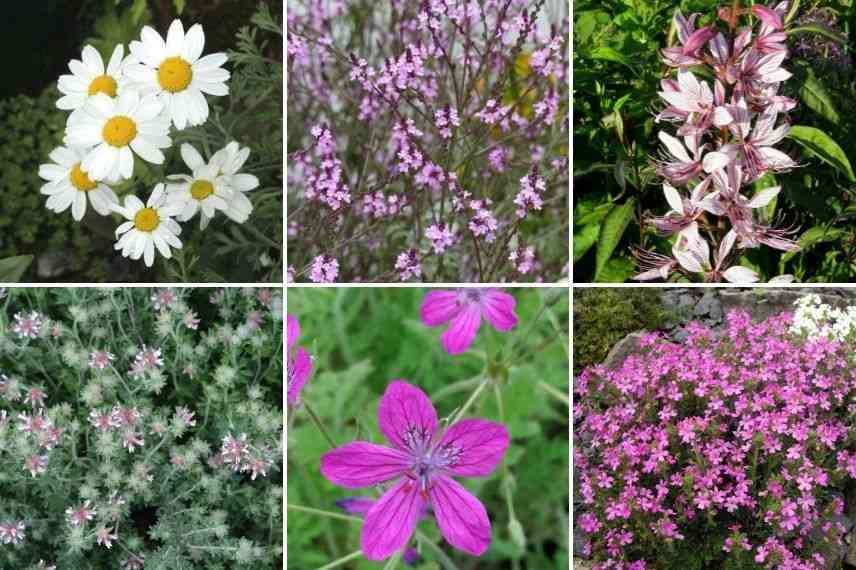
Anthemis carpatica ‘Karpatenschnee’, Erinus alpinus ‘Dr Hähnle’ (photo Wikipedia), Verbena officinalis var. grandiflora ‘Bampton’, Dorycnium hirsutum, Erodium manescavii, and Dictamnus albus var. purpureus
In a cut flower garden
Ensuring good vase life, the flowers of the cilium are often used in cut flower arrangements. So why not be tempted to create a cutting garden? Here are some ideal plants for this type of layout. I suggest the Anthemis tinctoria ‘Kelwayi’ which offers repeat flowering from May to June, then from September to October and self-seeds easily. In this dedicated space served by paths, you can combine this bright yellow flowering cilium with a cosmos (Cosmos bipinnatus ‘Antiquity’), the pot marigold, a perennial daisy, and a garden iris (for example, Iris germanica ‘Skyfire’ in a lovely orange hue). Don’t forget the grasses that are interesting for texturing floral arrangements, such as the Chinese fountain grass with its feathery inflorescences. For a touch of greenery in a bouquet, eucalyptus is an essential reference. For small gardens, opt for the Eucalyptus ‘Baby Blue‘ or the Eucalyptus gunnii ‘France Bleu Rengun‘ not exceeding 2.5 m in height at maturity.

Leucanthemum vulgare (photo pixabay), Anthemis tinctoria ‘Kelwayi’, Calendula officinalis, Cosmos ‘Antiquity’ (photo Fleuroselect), Eucalyptus ‘Baby Blue’ and Iris germanica ‘Skyfire’
In a rockery
Anthemis have the ability to thrive in soils that are not too rich, dry, calcareous, and well-drained. These perennials are therefore perfectly suited for planting in sunny rockeries. Choose a compact species or variety. For example, Anthemis punctata ssp. cupaniana is ideal for this situation. It showcases superb silvery foliage and offers white flowers with a yellow centre from June to July. This perennial does not exceed 30 cm in height at ripeness and tends to be spreading. To enhance your rockery, accompany it with Caucasian silene, which develops into a cushion about thirty centimetres in all directions and flowers profusely from August to October. It easily tolerates calcareous soils and occasional droughts. Pinks are the quintessential plants for dry rockeries. You might choose Dianthus deltoides ‘Brilliant’ with its vibrant magenta flowers or Dianthus knappii, a rare pink producing yellow flowers. At the edge of the rockery, install low-growing plants, such as perennial purslane. The ‘Wheels of Wonder’ series offers vibrant colours (orange and yellow for Delosperma Wheels of Wonder ‘Fire’)! Also consider sedums as groundcover with evergreen foliage that remains decorative even in winter. Perennials or shrubs with an erect habit help to structure the rockery: Agave americana, Phlomis fruticosa, eryngiums, cistus, and ornamental grasses.
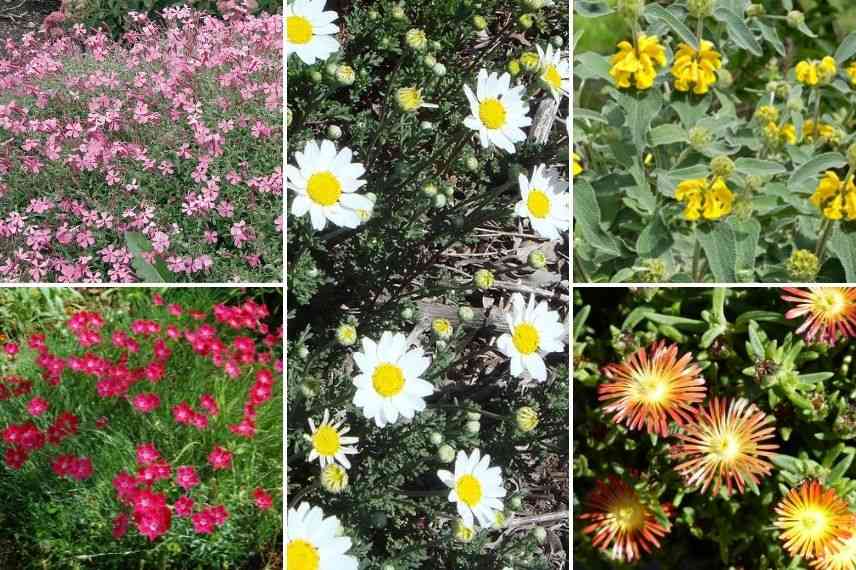
Silene schafta, Anthemis punctata ssp cupaniana (photo Xemenendura), Phlomis fruticosa, Dianthus deltoides ‘Brilliant’ (photo Mark Levisay) and Delosperma Wheels of Wonder ‘Fire’
⇒ Discover our selection of pinks for dry rockeries
On the edge
To beautifully highlight the edge of a path or a flowerbed, choose compact varieties and avoid those with excessive growth. Opt for perennials for sunny locations that tolerate dry soil. Highly floriferous, Anthemis carpatica ‘Karpatenschnee’ (or Carpathian chamomile) forms an ideal compact groundcover within a border. From May to August, it boasts numerous daisy-like flowers, white with a yellow centre. Its grey-green, aromatic foliage spreads to 30-40 cm in width. To extend the flowering period, combine the vegetation of this Cretan chamomile with the pink Alpine aster that blooms earlier in spring and the Sedum-leaved Aster which flowers in mauve from August to November. Both add beautiful colours. A sun-loving plant, Corsican spurge adds a golden touch during summer with its yellowish-green summer flowers. Additionally, its blue-green foliage complements our anthémis beautifully. Nepetas are also excellent border plants. I recommend Nepeta faassenii ‘Cat’s Pajamas’ and Nepeta racemosa ‘Grog’ with a compact habit that produce a generous flowering of intense violet-blue. Finally, Erigeron leiomerus softens the display with its pale flowers, pink to mauve.
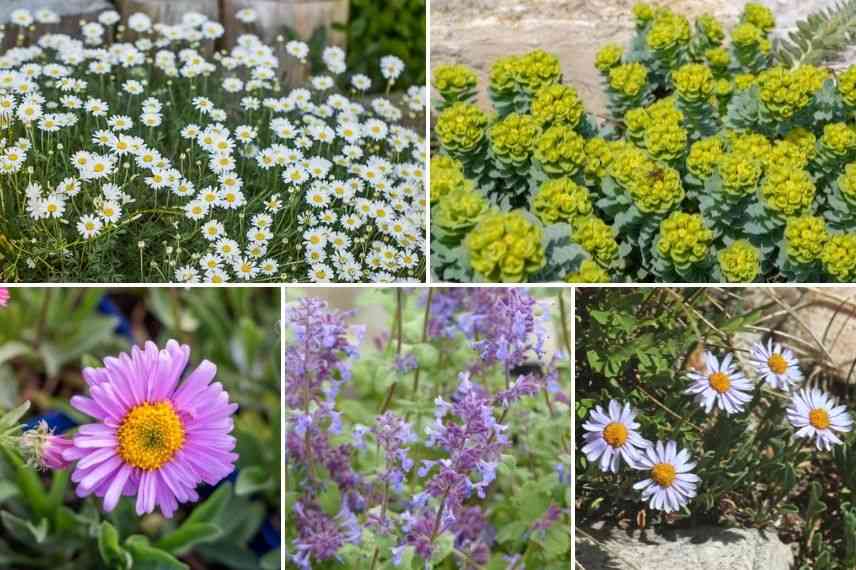
Anthemis carpatica ‘Karpatenschnee’ (photo mona larochelle), Euphorbia myrsinites, Aster alpinus ‘Happy End’ (photo Valleybrook Gardens – Flickr), Nepeta racemosa ‘Grog’ and Erigeron leiomerus
- Subscribe!
- Contents
































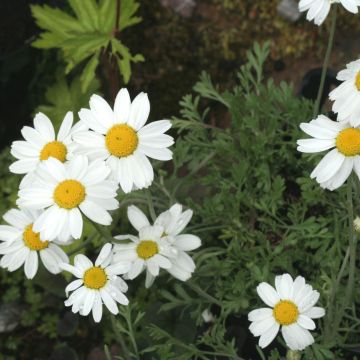
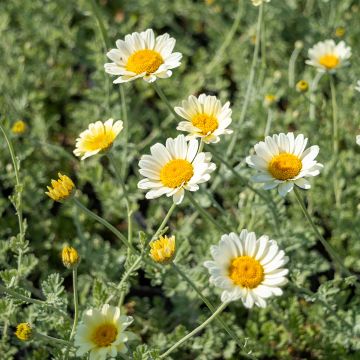




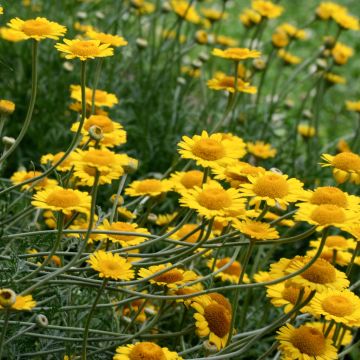

Comments